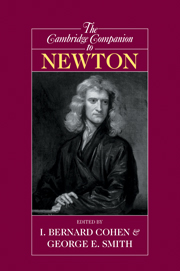Book contents
- Frontmatter
- Introduction
- 1 Newton's philosophical analysis of space and time
- 2 Newton's concepts of force and mass, with notes on the Laws of Motion
- 3 Curvature in Newton's dynamics
- 4 The methodology of the Principia
- 5 Newton's argument for universal gravitation
- 6 Newton and celestial mechanics
- 7 Newton's optics and atomism
- 8 Newton's metaphysics
- 9 Analysis and synthesis in Newton's mathematical work
- 10 Newton, active powers, and the mechanical philosophy
- 11 The background to Newton's chymistry
- 12 Newton's alchemy
- 13 Newton on prophecy and the Apocalypse
- 14 Newton and eighteenth-century Christianity
- 15 Newton versus Leibniz: from geometry to metaphysics
- 16 Newton and the Leibniz-Clarke correspondence
- Bibliography
- Index
4 - The methodology of the Principia
Published online by Cambridge University Press: 28 May 2006
- Frontmatter
- Introduction
- 1 Newton's philosophical analysis of space and time
- 2 Newton's concepts of force and mass, with notes on the Laws of Motion
- 3 Curvature in Newton's dynamics
- 4 The methodology of the Principia
- 5 Newton's argument for universal gravitation
- 6 Newton and celestial mechanics
- 7 Newton's optics and atomism
- 8 Newton's metaphysics
- 9 Analysis and synthesis in Newton's mathematical work
- 10 Newton, active powers, and the mechanical philosophy
- 11 The background to Newton's chymistry
- 12 Newton's alchemy
- 13 Newton on prophecy and the Apocalypse
- 14 Newton and eighteenth-century Christianity
- 15 Newton versus Leibniz: from geometry to metaphysics
- 16 Newton and the Leibniz-Clarke correspondence
- Bibliography
- Index
Summary
In the Preface to the first edition (1687) Newton informs the reader straight off that he intends the Principia to illustrate a new way of doing what we now call empirical science:
And therefore our present work sets forth mathematical principles of natural philosophy. For the whole difficulty of philosophy seems to be to find the forces of nature from the phenomena of motions and then to demonstrate the other phenomena from these forces. It is to these ends that the general propositions in Books 1 and 2 are directed, while in Book 3 our explanation of the system of the universe illustrates these propositions . . . If only we could derive the other phenomena of nature from mechanical principles by the same kind of reasoning! For many things lead me to have a suspicion that all phenomena may depend on certain forces by which the particles of bodies, by causes yet unknown, either are impelled toward one another and cohere in regular figures, or are repelled from one another and recede. Since these forces are unknown, philosophers have hitherto made trial of nature in vain. But I hope that the principles set down here will shed some light on either this mode of philosophizing or some truer one.
Surprisingly, however, the main body of the first edition contains only two further comments about methodology: (1) a cryptic remark at the end of the opening discussion of space and time, announcing that the purpose of the work is to explain “how to determine the true motions from their causes, effects, and apparent differences, and, conversely, how to determine from motions, whether true or apparent, their causes and effects”; and (2) a scholium buried at the end of Book 1, Section 11 in which Newton proposes that his distinctive approach will make it possible to argue more securely in natural philosophy.
- Type
- Chapter
- Information
- The Cambridge Companion to Newton , pp. 138 - 173Publisher: Cambridge University PressPrint publication year: 2002
- 31
- Cited by

